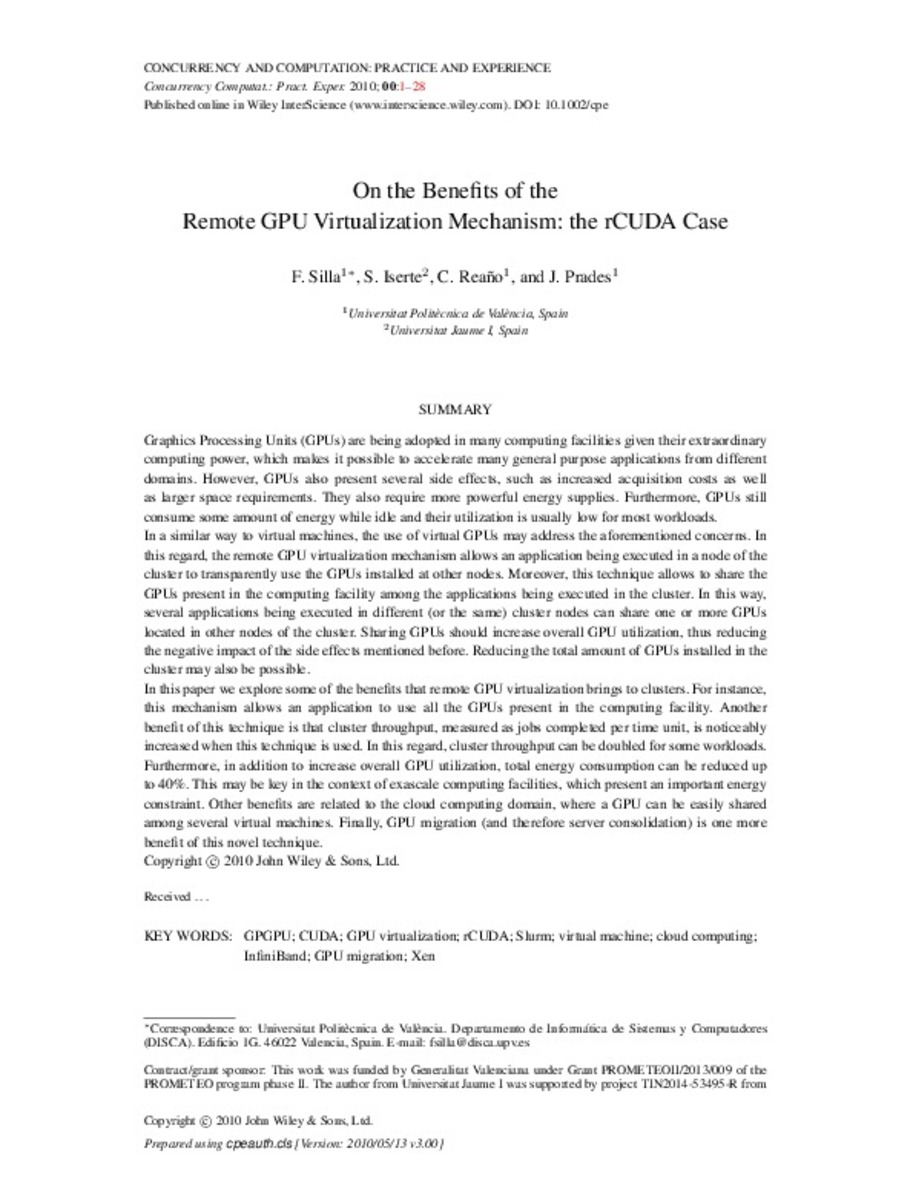Mostra el registre parcial de l'element
On the benefits of the remote GPU virtualization mechanism: The rCUDA case
| dc.contributor.author | Silla, Federico | |
| dc.contributor.author | Iserte, Sergio | |
| dc.contributor.author | Reaño, Carlos | |
| dc.contributor.author | Prades, Javier | |
| dc.date.accessioned | 2018-03-02T08:46:17Z | |
| dc.date.available | 2018-03-02T08:46:17Z | |
| dc.date.issued | 2017-07-10 | |
| dc.identifier.citation | SILLA, Federico, et al. On the benefits of the remote GPU virtualization mechanism: The rCUDA case. Concurrency and Computation: Practice and Experience, 2017, vol. 29, no 13. | ca_CA |
| dc.identifier.issn | 1532-0626 | |
| dc.identifier.issn | 1532-0634 | |
| dc.identifier.uri | http://hdl.handle.net/10234/173137 | |
| dc.description.abstract | Graphics processing units (GPUs) are being adopted in many computing facilities given their extraordinary computing power, which makes it possible to accelerate many general purpose applications from different domains. However, GPUs also present several side effects, such as increased acquisition costs as well as larger space requirements. They also require more powerful energy supplies. Furthermore, GPUs still consume some amount of energy while idle, and their utilization is usually low for most workloads. In a similar way to virtual machines, the use of virtual GPUs may address the aforementioned concerns. In this regard, the remote GPU virtualization mechanism allows an application being executed in a node of the cluster to transparently use the GPUs installed at other nodes. Moreover, this technique allows to share the GPUs present in the computing facility among the applications being executed in the cluster. In this way, several applications being executed in different (or the same) cluster nodes can share 1 or more GPUs located in other nodes of the cluster. Sharing GPUs should increase overall GPU utilization, thus reducing the negative impact of the side effects mentioned before. Reducing the total amount of GPUs installed in the cluster may also be possible. In this paper, we explore some of the benefits that remote GPU virtualization brings to clusters. For instance, this mechanism allows an application to use all the GPUs present in the computing facility. Another benefit of this technique is that cluster throughput, measured as jobs completed per time unit, is noticeably increased when this technique is used. In this regard, cluster throughput can be doubled for some workloads. Furthermore, in addition to increase overall GPU utilization, total energy consumption can be reduced up to 40%. This may be key in the context of exascale computing facilities, which present an important energy constraint. Other benefits are related to the cloud computing domain, where a GPU can be easily shared among several virtual machines. Finally, GPU migration (and therefore server consolidation) is one more benefit of this novel technique. | ca_CA |
| dc.format.extent | 17 p. | ca_CA |
| dc.format.mimetype | application/pdf | ca_CA |
| dc.language.iso | eng | ca_CA |
| dc.publisher | Wiley | ca_CA |
| dc.relation.isPartOf | Concurrency and Computation: Practice and Experience, 2017, vol. 29, no 13 | ca_CA |
| dc.rights | Copyright © John Wiley & Sons, Ltd. | ca_CA |
| dc.rights.uri | http://rightsstatements.org/vocab/InC/1.0/ | * |
| dc.subject | CUDA | ca_CA |
| dc.subject | GPU migration | ca_CA |
| dc.subject | GPU virtualization | ca_CA |
| dc.subject | InfiniBand | ca_CA |
| dc.subject | Slurm | ca_CA |
| dc.subject | Xen | ca_CA |
| dc.title | On the benefits of the remote GPU virtualization mechanism: The rCUDA case | ca_CA |
| dc.type | info:eu-repo/semantics/article | ca_CA |
| dc.identifier.doi | http://dx.doi.org/10.1002/cpe.4072 | |
| dc.relation.projectID | Generalitat Valenciana / PROMETEOII/2013/009; MINECO; FEDER / TIN2014-53495-R | ca_CA |
| dc.rights.accessRights | info:eu-repo/semantics/openAccess | ca_CA |
| dc.relation.publisherVersion | http://onlinelibrary.wiley.com/doi/10.1002/cpe.4072/full | ca_CA |
| dc.type.version | info:eu-repo/semantics/submittedVersion | ca_CA |
Fitxers en aquest element
Aquest element apareix en la col·lecció o col·leccions següent(s)
-
ICC_Articles [419]







